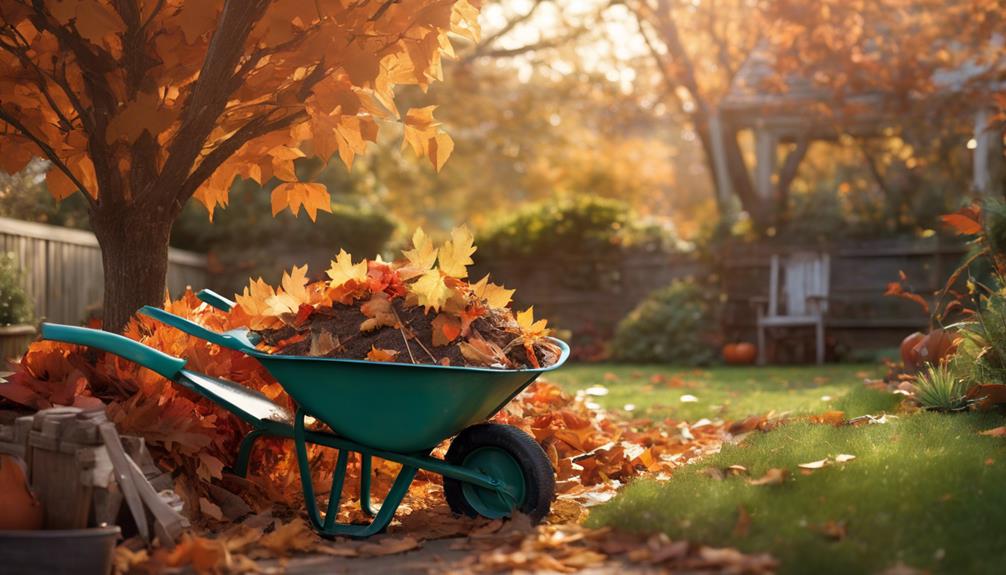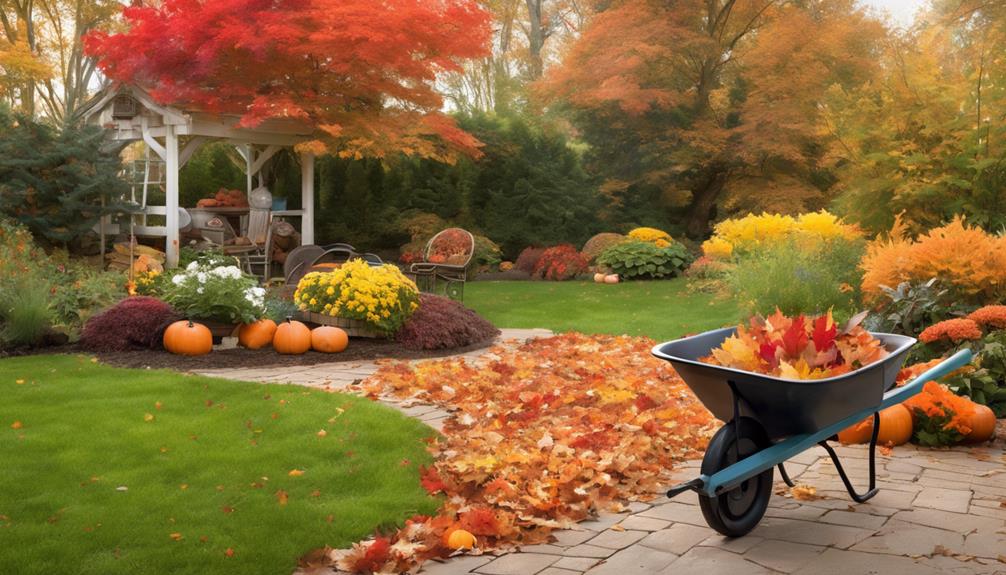
Soft Landscaping Selly Oak
11 March 202510 Best Tools for Hedge Trimming Success
11 March 2025Understanding seasonal garden cleanup service costs involves considering several factors.
Pricing is influenced by garden size, service complexity, and location. Typically, hourly rates range from £50 to £150, depending on the services requested, such as leaf removal or pruning.
Seasonal demand can also affect costs, particularly during peak times. Provider expertise and equipment can command higher fees.
Moreover, addressing soil quality and pest control may incur further expenses. By evaluating these elements, you can better manage your gardening budget.
Investigate the nuances further to gain extensive insight into seasonal gardening service costs.
Seasonal Garden Maintenance Costs
Seasonal garden maintenance costs are influenced by various factors, including the size of the garden, the specific services required, and the frequency of maintenance.
Understanding average service rates can assist homeowners in budgeting effectively for these essential tasks.
Factors Influencing Pricing
Several factors influence the pricing of seasonal garden maintenance services, impacting both the cost to homeowners and the services provided.
The size and complexity of the garden play a critical role; larger or intricately designed spaces typically require more labour and resources.
Moreover, the specific services requested—such as pruning, fertilisation, or pest control—can greatly affect pricing.
Geographic location is another determinant, as labour costs and regional demand vary widely.
Seasonal variations also come into play; services during peak growing seasons may incur higher charges due to increased demand for skilled labour.
Lastly, the experience and reputation of the service provider can influence costs, as established professionals may command premium fees for their expertise and reliability.
Average Service Rates
While costs can vary considerably based on multiple factors, average service rates for seasonal garden maintenance typically range from £50 to £150 per hour.
This pricing reflects the complexity of the services provided, including lawn care, mulching, pruning, and debris removal. Geographic location also plays a significant role, as demand and labour costs fluctuate regionally.
Furthermore, the level of expertise and equipment utilised by the service provider can influence rates; specialists with advanced horticultural knowledge may command higher fees.
For clients seeking extensive packages, many companies offer flat-rate pricing based on the size of the garden and the scope of work required.
Understanding these averages equips homeowners to make informed decisions when selecting a seasonal maintenance service.
Labor and Material Costs
When evaluating labour and material costs for seasonal garden cleanup, several key factors come into play.
Soil quality assessment is crucial for determining the health of the garden, while pest control measures are necessary to protect plants from infestations.
Furthermore, evaluating the irrigation system ensures that water management is efficient and effective, impacting both labour and material expenses.
Soil Quality Assessment
Soil quality assessment is a critical component of any seasonal garden clean-up, as it directly influences plant health and overall garden productivity. Evaluating soil conditions requires both labour and materials, often contributing significantly to the comprehensive clean-up costs.
Professionals typically conduct tests to analyse pH levels, nutrient content, and soil structure.
Key factors affecting soil quality assessment costs include:
- Soil Testing Kits: Costs vary based on complexity and accuracy.
- Labour: Skilled personnel may charge higher rates for their expertise.
- Amendments: Organic matter or fertilisers may be necessary for improvement.
- Equipment: Specialised tools for sampling and analysis can add to expenses.
Investing in a thorough soil quality assessment guarantees the best growing conditions for your garden.
Pest Control Measures
Addressing pest control measures is vital following a thorough soil quality assessment, as healthy soil can attract various pests that threaten plant health.
Understanding the costs associated with pest control involves both labour and materials, which can vary based on the severity of the infestation and the chosen methods.
- Labour Costs: Professional pest control services charge based on time and expertise required.
- Chemical Treatments: The cost of pesticides can differ considerably, influenced by the product's effectiveness and environmental impact.
- Preventative Measures: Investing in barriers or natural deterrents can mitigate future infestations.
- Follow-up Services: Regular monitoring and maintenance are critical for sustained pest management, contributing to ongoing costs.
Mastery in pest control requires an understanding of these factors to achieve a healthy, thriving garden.
Irrigation System Evaluation
A thorough irrigation system evaluation is essential for maintaining ideal water efficiency in a garden, with costs typically divided into labour and materials. Evaluating your system ensures peak performance and identifies potential issues that could lead to water waste or plant stress.
Key factors influencing costs include:
- Labour: Technicians assess system functionality, identifying leaks or inefficiencies.
- Materials: Replacement parts such as emitters, hoses, and controllers may be necessary.
- System Complexity: More intricate systems require additional time and expertise, escalating labour costs.
- Accessibility: Difficult-to-reach areas may necessitate specialised equipment or techniques, increasing total expenses.
Investing in an irrigation evaluation not only enhances water conservation but also promotes healthier garden growth, aligning economic and ecological interests.
Gather Necessary Tools
Effective seasonal garden cleanup begins with careful planning and preparation, ensuring that all necessary tools are gathered beforehand.
Key tasks such as mulching for moisture retention and employing soil aeration methods require specific equipment to achieve optimal results.
Initial Planning and Preparation
Before commencing a seasonal garden cleanup, it is crucial to gather the appropriate tools to ensure efficiency and effectiveness throughout the process.
Having the right equipment at your disposal not only streamlines the cleanup but also enhances the quality of your work. Proper preparation prevents unnecessary delays and ensures that each task is executed with precision.
- Pruning Shears: Essential for cutting back overgrown plants and shaping hedges.
- Rake: Useful for collecting leaves and debris, promoting a tidy garden space.
- Garden Fork: Ideal for turning soil and aerating compacted areas.
- Gloves: Protect your hands while providing a secure grip on tools.
Mulching for Moisture Retention
Mulching is a vital practice for maintaining soil moisture and promoting healthy plant growth in your garden. By covering the soil with organic or inorganic materials, you can effectively reduce evaporation, suppress weeds, and improve soil structure.
To ensure optimal results, gathering the right tools is essential.
Consider the following items for your mulching project:
- Mulch Fork: To spread and aerate mulch evenly.
- Garden Gloves: To protect your hands while handling materials.
- Wheelbarrow: For efficient transport of mulch to your garden beds.
- Rake: To level and smooth out the mulch layer.
Equipped with these tools, you can implement a mulching strategy that significantly improves moisture retention, ultimately benefiting your plants and overall garden health.
Soil Aeration Methods
Maintaining soil health is not only about moisture retention; it also involves ensuring proper aeration to promote root growth and nutrient absorption.
Effective soil aeration methods can greatly improve the overall condition of your garden. To achieve the best results, it is crucial to gather the necessary tools for aeration.
- Core Aerator: Removes soil plugs to alleviate compaction.
- Spike Aerator: Creates holes in the soil, allowing air and water penetration.
- Garden Fork: Useful for smaller areas where precision is needed.
- Aeration Shoes: Convenient for walking over lawns while aerating.
Employing these tools will facilitate improved soil structure, boost microbial activity, and ultimately lead to a thriving garden ecosystem.
Enhanced Plant Growth Potential
Unveiling the full potential of your garden begins with a comprehensive seasonal cleanup, which lays the groundwork for enhanced plant growth. By removing debris, dead foliage, and weeds, you create an optimal environment for plants to flourish. This process not only improves sunlight penetration but also fosters better air circulation and soil health.
| Benefits of Seasonal Cleanup | Impact on Plant Growth |
|---|---|
| Improved soil structure | Enhanced root development |
| Increased nutrient availability | Greater plant vigour |
| Reduced pest habitat | Lower disease incidence |
| Improved water retention | Optimal moisture access |
| Better light exposure | Accelerated photosynthesis |
Organic Fertilizer Usage
The use of organic fertiliser plays an essential role in promoting a healthy garden ecosystem.
Techniques such as compost tea application, organic pest deterrent sprays, and beneficial microbial inoculant application not only improve soil fertility but also support sustainable gardening practices.
Understanding these methods can significantly contribute to improved plant health and resilience.
Compost Tea Application
Compost tea application has emerged as an effective method for improving soil health and promoting plant growth in gardens. This organic fertiliser, made by steeping compost in water, extracts beneficial microorganisms and nutrients that enrich the soil.
By incorporating compost tea into your gardening routine, you can foster a thriving ecosystem that supports robust plant development.
Key benefits of compost tea application include:
- Improved Soil Structure: Enhances aeration and water retention capabilities.
- Nutrient Availability: Supplies vital macro and micronutrients to plants.
- Microbial Diversity: Introduces beneficial microorganisms that suppress pathogens.
- Cost-Effective Solution: Reduces the need for synthetic fertilisers while improving sustainability.
Organic Pest Deterrent Spray
In the pursuit of sustainable gardening practices, utilising an organic pest deterrent spray is an effective strategy to protect plants from harmful insects while maintaining environmental integrity.
These sprays, derived from natural ingredients, serve to create a hostile environment for pests without compromising soil health or biodiversity.
Key benefits include:
- Eco-Friendly: Reduces chemical runoff and protects beneficial insects.
- Plant Health: Supports overall plant vitality by minimising stress from pests.
- Cost-Effective: Often made from household ingredients, reducing reliance on commercial products.
- Targeted Action: Can be formulated to address specific pest issues while leaving beneficial organisms unharmed.
Implementing organic pest deterrents aligns with a holistic approach to gardening, promoting resilience and sustainability.
Beneficial Microbial Inoculant Application
A beneficial microbial inoculant is a vital component of sustainable gardening practices, enhancing soil health and plant growth through the introduction of beneficial microorganisms.
This application not only improves nutrient availability but also fosters a resilient ecosystem within the soil. Utilising these inoculants can lead to robust plant development and sustainable gardening practices.
- Enhanced Nutrient Uptake: Promotes absorption of essential minerals and nutrients.
- Soil Structure Improvement: Encourages aggregation, improving aeration and water retention.
- Pest and Disease Resistance: Strengthens plant defences against pathogens and pests.
- Long-term Soil Fertility: Builds a sustainable soil microbiome, reducing reliance on chemical fertilisers.
Integrating microbial inoculants into your gardening routine guarantees a thriving environment for both plants and soil.
Weather-Related Plant Damage
Weather-related plant damage can significantly impact the health and appearance of gardens, necessitating effective management strategies.
Implementing frost protection techniques, adjusting irrigation for drought conditions, and selecting pest-resistant plants are vital steps to mitigate these risks.
Frost Protection Techniques
Frost can pose a considerable threat to delicate plants, leading to potential damage or even loss if not properly managed.
Employing effective frost protection techniques is crucial for safeguarding your garden. Here are several strategies to consider:
- Row Covers: Lightweight fabric that insulates plants while allowing light and moisture in.
- Mulching: Applying organic materials around the base of plants to retain soil warmth and mitigate frost penetration.
- Windbreaks: Planting trees or installing fences to shield vulnerable plants from cold winds.
- Heat Sources: Utilising outdoor lights or heat lamps to raise temperatures around sensitive plants during frost events.
Implementing these techniques can greatly reduce the risk of frost-related damage, ensuring your garden thrives despite chilly conditions.
Irrigation Adjustments for Drought Conditions
Drought conditions can severely impact plant health, leading to stress and potential loss if not properly addressed.
Adjusting irrigation practices is essential to mitigate these effects and ensure optimal plant vitality. Proper management of water resources can enhance resilience against drought, promoting healthy growth even under adverse conditions.
- Implement drip irrigation to minimise water waste and target root zones.
- Schedule irrigation during the early morning or late evening to reduce evaporation.
- Utilise soil moisture sensors to tailor watering schedules based on actual needs.
- Incorporate mulch to retain soil moisture and regulate temperature.
Pest-Resistant Plant Selection
How can gardeners best protect their plants from the increasing threats posed by pests in a changing climate? The selection of pest-resistant plants is paramount in mitigating weather-related plant damage.
By choosing species that exhibit innate resistance to local pests, gardeners can enhance their landscape's resilience and reduce reliance on chemical treatments.
Consider the following strategies when selecting pest-resistant plants:
- Native Species: Often well-adapted to local conditions and naturally resistant to local pests.
- Companion Planting: Utilise plants that deter pests naturally when grown alongside more vulnerable species.
- Diversity: Incorporate a wide variety of plants to disrupt pest life cycles and reduce infestations.
- Seasonal Selection: Choose plants that thrive in your climate's specific seasonal conditions, thereby improving overall health.
These strategies promote a sustainable approach to gardening.
Why Choose TKL Birmingham Gardener
When it comes to seasonal garden clean-up, choosing TKL Birmingham Gardener ensures a reliable and efficient service tailored to your specific needs.
Our team comprises highly skilled professionals with extensive knowledge of horticultural practices, guaranteeing that your garden receives the meticulous care it deserves. We employ advanced techniques and state-of-the-art equipment to deliver superior results, enhancing both the health and aesthetic appeal of your garden.
Moreover, TKL Birmingham Gardener places a strong emphasis on sustainable practices, promoting ecological balance within your outdoor space.
Our flexible scheduling accommodates your timeline, making the clean-up process seamless. By selecting us, you invest in a partnership dedicated to excellence, where your vision is brought to life through expert execution.
Experience the difference with TKL Birmingham Gardener, where your garden's potential is fully realised.
Common Seasonal Cleanup Questions
When considering seasonal garden clean-up, many homeowners have questions regarding the process, costs, and expectations. A common inquiry revolves around the specific services included in a clean-up. Typically, these encompass leaf removal, bed tidying, pruning, and debris disposal.
Homeowners also often wonder about the frequency of these services; while spring and autumn clean-ups are most prevalent, supplementary sessions may be warranted depending on garden size and local climate.
Cost-related questions are common as well, with prices influenced by factors such as garden size, service complexity, and local labour rates. Understanding the timeline for completion is crucial, as larger properties may require multiple visits.
Clarity on these aspects can greatly improve the decision-making process.
Finalizing Your Cleanup Schedule
Once homeowners have a clear understanding of the services offered and the associated costs, the next step is to finalise a cleanup schedule that aligns with their garden's needs and seasonal changes.
Establishing a thoughtful timeline is essential to ensure optimal garden health and aesthetic appeal throughout the year. Considerations should include local climate patterns, plant growth cycles, and personal availability.
- Assess peak seasons for plant growth and debris accumulation
- Schedule clean-ups prior to major seasonal shifts
- Coordinate with any ongoing landscaping projects
- Allow flexibility for unexpected weather changes




